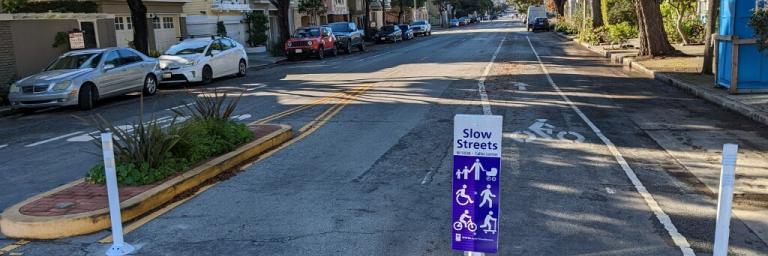The Lake Slow Street is an effort to improve safety and support active transportation on this corridor from 28th Avenue to Arguello Boulevard, providing an important east-west connection through the Richmond neighborhood. Lake Street was initially designated as a COVID-19 Response Slow Street in April 2020, and approved by the San Francisco Municipal Transportation Agency (SFMTA) Board as a post-pandemic Slow Street in August 2021. On December 6, 2022, the SFMTA Board affirmed Lake Street’s inclusion in the ongoing Slow Streets program.
Learn more about the Slow Streets program
Lake Slow Street Evaluation
The SFMTA Project team collects data to assess how each Slow Street is performing against the Slow Streets Program targets:
- Vehicle speeds at or below 15 mph
- Vehicle volumes less than 1,000 per day
See the latest evaluation in the “Related Reports & Documents” section on the right side of this webpage. For additional information on how this street compares to others in the Slow Streets program, or for overall program findings, please see the 2023 Evaluation Report.
Background
Lake Street was initially introduced as a Slow Street during the pandemic response phase of the program in 2020. Following a program-wide outreach process to measure the effectiveness of COVID-19 Response Slow Streets in 2021, Lake Street proved to have high rates of use and vehicle speeds and volumes that met criteria for a low-stress street. Additionally, Lake Street fulfilled a need for a safe, calm, east-west bike connection through the Richmond. Based on the outcome of that evaluation, the SFMTA Slow Streets team recommended that Lake Street—along with Golden Gate Avenue, Sanchez Street, and Shotwell Street—be made post-pandemic Slow Streets by SFMTA Board. The Board approved the recommendation, and outreach to develop a more robust design for Lake Street began in the Winter of 2021. This phase of outreach included a survey, three virtual open house meetings, and numerous virtual and in-person community meetings. The design outreach phase for Lake Street revealed deep neighborhood divisions around the concept of the Slow Street, and significantly extended the process to arrive at a design concept for the corridor. Ultimately, the City Traffic Engineer approved a design for Lake Street that prioritized traffic control and calming in the Summer of 2022. That design was substantially implemented as of Fall 2022.
In December 2022, the SFMTA Slow Streets team brought a plan for an ongoing Slow Streets Program to the SFMTA Board for approval. Because this represented the creation of a new program for the City, it was necessary to re-authorize the four previously-approved “post-pandemic” Slow Streets as part of the new Slow Streets Program. On December 6, 2022, the ongoing Slow Streets Program for San Francisco was approved, and Lake Street was among the 16 initial corridors included in the Program. The ongoing Slow Streets Program establishes a set of data-driven criteria for measuring the success of Slow Streets, and includes an expanded design toolkit for implementing Slow Streets. The Slow Streets Program team will be evaluating Lake Street to determine if the previously-implemented design needs to be refined to meet the new Program criteria for vehicle volumes and speeds following the approval of the permanent program.
Lake Slow Street Design
This design was approved in August 2022 to calm traffic and slow speeds using speed humps, raised crosswalks, and new stop signs. View the design details in the results of the August 5, 2022 Engineering Public Hearing.
Sign up for future updates via the link on the righthand side of the page, and email SlowStreets@SFMTA.com with “Lake Street” in the subject line with any questions or feedback.
Questions? Please reach out to the project team at SlowStreets@SFMTA.com and include "Lake Street" in the subject line. To receive updates, please sign up via the link on the righthand side of this page.
